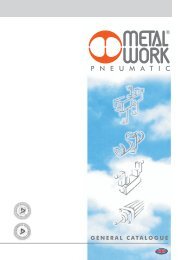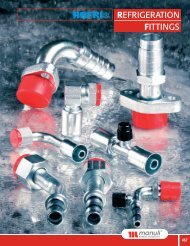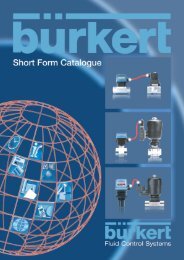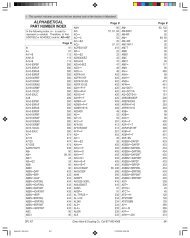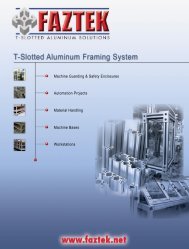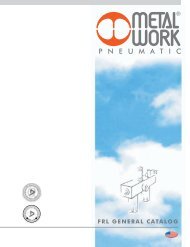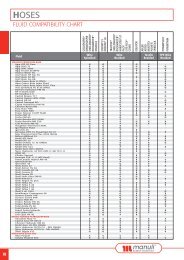- Page 1 and 2:
Fluid Control SystemsSelected produ
- Page 3 and 4:
Your personal copy of the newBürke
- Page 6 and 7:
Experience you can rely onBürkert
- Page 8:
Solenoid valvesA uniquecomprehensiv
- Page 11 and 12:
Customised solutions are our added
- Page 13 and 14:
Control Valve - request for quotati
- Page 15 and 16:
➔the comprehensive automation sol
- Page 18 and 19:
16Mass Flow Controller and Mass Flo
- Page 21 and 22:
01Solenoid Valves19
- Page 23 and 24:
212/2 and 3/2-way solenoid valvesFo
- Page 25 and 26:
232/2 and 3/2-way solenoid valvesFo
- Page 27 and 28:
25Dimensions [mm]Bottom viewPort co
- Page 29 and 30:
27Solenoid Valves 6011Subject to mo
- Page 31 and 32:
29Dimensions [mm]Port Body Coil Coi
- Page 33 and 34:
31 Solenoid ValvesOrdering chart fo
- Page 35 and 36:
108.5 (with G1/2)105 (with G1/4)33D
- Page 37 and 38:
35Solenoid Valves 0255Subject to mo
- Page 39 and 40:
37Body A and BDimensions [mm]Body B
- Page 41 and 42:
39Solenoid Valves 0256Subject to mo
- Page 43 and 44:
41Dimensions [mm]Version A B CThrea
- Page 45 and 46:
43Valve versionMax. operating press
- Page 47 and 48:
45Dimensions [mm]Possible connectio
- Page 49 and 50:
47Possible connectionsCircuit funct
- Page 51 and 52:
49Ordering chart for valves (other
- Page 53 and 54:
51Possible connectionsCircuit funct
- Page 55 and 56:
53Ordering chart for flange valve m
- Page 57 and 58:
55Dimensions [mm]Ordering chart for
- Page 59 and 60:
57Dimensions [mm]The ports marked w
- Page 61 and 62:
59Dimensions [mm]Body materialD B E
- Page 63 and 64:
61Dimensions [mm]DN A D (spigot con
- Page 65 and 66:
63Dimensions [mm]DN [mm] G A B C D
- Page 67 and 68:
65Dimensions [mm]Threaded portDN D
- Page 69 and 70:
67Ordering chart for valves (other
- Page 71 and 72:
69Dimensions [mm]G Thread AC coil D
- Page 73 and 74:
71Solenoid Valves 6213Subject to mo
- Page 75 and 76:
73Dimensions [mm]DN [mm] G B C D F
- Page 77 and 78:
75Dimensions [mm] according to DIN
- Page 79 and 80:
77Delivered as circuit function ACh
- Page 81 and 82:
79Solenoid Valves 5282Subject to mo
- Page 83 and 84:
81Dimensions [mm]All versions PVC-b
- Page 85 and 86:
83Dimensions [mm]DN D B E F L20 NPT
- Page 87 and 88:
85Dimensions [mm]DN D B E F H J13 N
- Page 89 and 90:
87Dimensions [mm]DN D B E F H J13 N
- Page 91 and 92:
89Dimensions [mm]DN A B D H L R8 46
- Page 93:
91Dimensions [mm]DN A B D H L R8.0
- Page 96 and 97:
94Overview of Process Valves and Co
- Page 98 and 99:
96Control Heads for pneumatically o
- Page 100 and 101:
98Selection guide for Process Valve
- Page 102 and 103:
100Selection guide sorted by applic
- Page 104 and 105:
1022/2-way Angle-Seat Valvefor medi
- Page 106 and 107:
104Flow direction below seatProcess
- Page 108 and 109:
1063/2-way Angle-Seat Valve, compac
- Page 110 and 111:
108Process Valves 2002Ordering char
- Page 112 and 113:
1102/2-way Globe Valvefor media up
- Page 114 and 115:
112Dimensions [mm]2012With flange c
- Page 116 and 117:
114Ordering chart for valves with f
- Page 118 and 119:
116Ordering chart for valves with f
- Page 120 and 121:
1182/2-way Diaphragm Valve with pla
- Page 122 and 123:
120Ordering chart for DN 15-50 valv
- Page 124 and 125:
1222/2-way Diaphragm Valve, stainle
- Page 126 and 127:
124Ordering chart for valvesFlange
- Page 128 and 129:
1262/2-way Diaphragm Valve, forged
- Page 130 and 131:
128Process Valves 2031 ForgedOrderi
- Page 132 and 133:
1302-way Diaphragm Valve, with plas
- Page 134 and 135:
1322-way Diaphragm Valve, with cold
- Page 136 and 137:
134Ordering chart (other versions o
- Page 138 and 139:
1362-way Diaphragm Valve, forged st
- Page 140 and 141:
138Process Valves 3233 ForgedOrderi
- Page 142 and 143:
140Zero Deadleg T Valve, pneumatica
- Page 144 and 145:
142Tank Bottom Valve,pneumatically
- Page 146 and 147:
144Zero Deadleg T-Valve, ManuallyOp
- Page 148 and 149:
146Tank Bottom Valve, Manually Oper
- Page 150 and 151:
148Electric Rotary Actuator forQuar
- Page 152 and 153:
1502/2-way Angle Seat Control Valve
- Page 154 and 155:
1522/2-way Globe Control Valve• N
- Page 156 and 157:
154Diaphragm Control Valve, forged
- Page 158 and 159:
156
- Page 160 and 161:
158Overview of Process Pneumatics C
- Page 162 and 163:
160Selection guide for Process Pneu
- Page 164 and 165:
162Selection guide for Process Pneu
- Page 166 and 167:
1642/2-way Miniature Solenoid Valve
- Page 168 and 169:
16660115 ø7.2UNF 10-324.317M526141
- Page 170 and 171:
1682/2-way Compact Solenoid Valve
- Page 172 and 173:
170Ordering chart for valvesGeneral
- Page 174 and 175:
1723/2-way Miniature Solenoid Valve
- Page 176 and 177:
174Single manifoldAccessoryProcess
- Page 178 and 179:
1763/2-way Miniature Direct Mountin
- Page 180 and 181:
1783/2-way Miniature Solenoid Valve
- Page 182 and 183:
180Ordering chart for valvesValves
- Page 184 and 185:
1823/2-way Direct Mounting Pilot Va
- Page 186 and 187:
1843/2-way Miniature Rocker Solenoi
- Page 188 and 189:
186Ordering chart for single manifo
- Page 190 and 191:
1883/2-way Solenoid Valvesub-base c
- Page 192 and 193:
190Ordering chart for valves (other
- Page 194 and 195:
1922/2-way Solenoid Valvewith servo
- Page 196 and 197:
1943/2-way Solenoid Valvefor gases
- Page 198 and 199:
1962/2 or 3/2-way Solenoid Valvefor
- Page 200 and 201:
1983/2, 5/2 and 5/3-way Solenoid Va
- Page 202 and 203:
200Manifold assembly with pneumatic
- Page 204 and 205:
2025/2 and 3/2-way Solenoid Valvefo
- Page 206 and 207:
2044/2-way Solenoid Valvefor pneuma
- Page 208 and 209:
2063/2 and 4/2-way Solenoid Valvefo
- Page 210 and 211:
2083/2 and 4/2-way Solenoid Valvefo
- Page 212 and 213:
210Manifold assembly from pneumatic
- Page 214 and 215:
2123/2 and 4/2-way Solenoid Valvefo
- Page 216 and 217:
214Options for service portProcess
- Page 218 and 219:
2163/2 and 5/2-way Solenoid Valvefo
- Page 220 and 221:
218Ordering chart for Type MP12 pne
- Page 222 and 223:
220Modular pneumatic valve island
- Page 224 and 225:
222Remote Process Actuation Control
- Page 226 and 227:
224
- Page 228 and 229:
226Selection guide for Analytical V
- Page 230 and 231:
2282/2 and 3/2-way Flipper Solenoid
- Page 232 and 233:
230Dimensions of valves with tube h
- Page 234 and 235:
2322/2 and 3/2-way Rocker Solenoid
- Page 236 and 237:
234Dimensions [mm]Complete valves w
- Page 238 and 239:
2362/2 or 3/2-way Rocker Solenoid V
- Page 240 and 241:
2382/2 or 3/2-way Miniature RockerS
- Page 242 and 243:
2402/2 or 3/2-way Solenoid Valvefor
- Page 244 and 245:
2422/2 or 3/2-way Solenoid Valvefor
- Page 246 and 247:
244
- Page 248 and 249:
246Selection guide for Flow Control
- Page 250 and 251:
248Overview of Flow Control with Pa
- Page 252 and 253:
250Overview of Flow Control with Ba
- Page 254 and 255:
252Overview of Flow Control with Ma
- Page 256 and 257:
254Paddle-wheel sensor for low flow
- Page 258 and 259:
256INLINE flow sensor8030Type 8030
- Page 260 and 261:
258INLINE flow sensor - II 1 G/D•
- Page 262 and 263:
260Safety instructions - Notice of
- Page 264 and 265:
262INLINE flow switchwith On/Off in
- Page 266 and 267:
264INLINE flow transmitter• Flow
- Page 268 and 269:
266INLINE flow batch controller•
- Page 270 and 271:
268INLINE fitting with paddle-wheel
- Page 272 and 273:
FLOWFLOWFLOWFLOWFLOWFLOWFLOW270Pres
- Page 274 and 275:
272INLINE fitting dimensionsFlange
- Page 276 and 277:
274Positive Displacement Flow Trans
- Page 278 and 279:
276Ordering chart for fitting S070i
- Page 280 and 281:
278INSERTION flow sensor8020Type 80
- Page 282 and 283:
280INSERTION flow transmitter• 15
- Page 284 and 285:
282System versions - Panel-mounted
- Page 286 and 287:
284INSERTION batch controller• 15
- Page 288 and 289:
286System versions - Panel-mounted
- Page 290 and 291:
288Electromagnetic flow transmitter
- Page 292 and 293:
290Electromagnetic flow transmitter
- Page 294 and 295:
292INSERTION fittingfor flow measur
- Page 296 and 297:
H294Flow diagram: selection of fitt
- Page 298 and 299:
296Sensors S020Insertion fitting di
- Page 300 and 301: 298Ordering chart - Fitting S020S02
- Page 302 and 303: 300Full Bore Magflowmeter forContin
- Page 304 and 305: 302Dimensions [mm] Electronic Type
- Page 306 and 307: 304Selection guide for Level Contro
- Page 308 and 309: 306Selection guide for Pressure Con
- Page 310 and 311: 308Pressure Transmitter (2-wire) /
- Page 312 and 313: 310Pressure Transmitter• Ceramic
- Page 314 and 315: 312Pressure Transmitterfor general
- Page 316 and 317: 314Selection guide for Temperature
- Page 318 and 319: 316Screw-in Temperature Sensor / Sw
- Page 320 and 321: 318Selection guide for Analytical C
- Page 322 and 323: 320Overview of Analytical Control p
- Page 324 and 325: 322Digital pH Transmitter, Compact
- Page 326 and 327: 324Ordering chart for accessoriesSe
- Page 328 and 329: 326Digital O.R.P. Transmitter,compa
- Page 330 and 331: 328Ordering chart for accessoriesSe
- Page 332 and 333: 330Digital Conductivity Transmitter
- Page 334 and 335: 332Ordering chart for the Type 8225
- Page 336 and 337: 334Digital Inductive ConductivityTr
- Page 338 and 339: 336Ordering chart for accessoriesSe
- Page 340 and 341: 338INSERTION fittingfor analysis me
- Page 342 and 343: 340Sensors S020Dimensions [mm] oftr
- Page 344 and 345: 342Insertion fitting dimensionsTrue
- Page 346 and 347: 344Accessories: measuring chamber f
- Page 348 and 349: 346
- Page 352 and 353: 350Type selection diagram for Propo
- Page 354 and 355: 352Proportional Valves 2821/6022/23
- Page 356 and 357: 354Proportional Valve Low-∆p• C
- Page 358 and 359: 356Proportional Valvewith control e
- Page 360 and 361: 358Control Electronicsfor Proportio
- Page 362 and 363: 360Mass Flow Controller (MFC)for ga
- Page 364 and 365: 362
- Page 366 and 367: 364Selection guide for ControllersA
- Page 368 and 369: 366Digital Timer Unitwith 4 switch
- Page 370 and 371: 368Digital Timer unitwith 8 switch
- Page 372 and 373: 370Compact Plug-on Flow Controllerf
- Page 374 and 375: 372Compact Plug-on Flow PressureCon
- Page 376 and 377: 374Compact Temperature Controller
- Page 378 and 379: 376
- Page 380 and 381: 378Subject to modificationsApproval
- Page 382 and 383: 3802/2-way Compact General PurposeS
- Page 384 and 385: 3823/2-way Compact Solenoid Valvewi
- Page 386 and 387: 3842/2-way Solenoid Valvefor neutra
- Page 388 and 389: 3862/2-way Solenoid Valvewith servo
- Page 390 and 391: 388Ordering chart for valves (other
- Page 392 and 393: 3905/2 and 5/3-way Solenoid Valve f
- Page 394 and 395: 392Manifold assembly with Type MP07
- Page 396 and 397: 3945/2 and 3/2-way Solenoid Valve f
- Page 398 and 399: 3963/2-way I.S. Solenoid Valvefor p
- Page 400 and 401:
3985/2 and 5/3-way I.S. Solenoid Va
- Page 402 and 403:
4003/2 and 5/2-way I.S. Solenoid Va
- Page 404 and 405:
402
- Page 406 and 407:
404Cable Plug to DIN EN 175301-803,
- Page 408 and 409:
406Industry standard Cable Plug,For
- Page 410 and 411:
408Cable Plug to DIN EN 175301-803,
- Page 412 and 413:
410 Bürkert - your local business
- Page 415:
03/06 / © Burkert Contromatic Inc.



